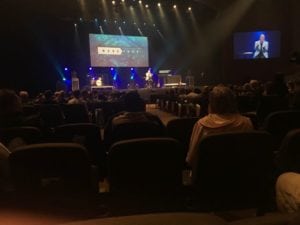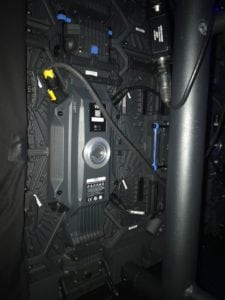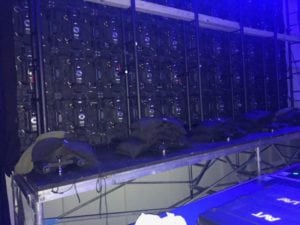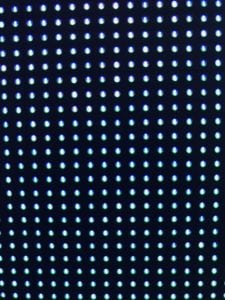Everywhere you look, churches are ditching projectors for either TVs or LED walls to use for their church displays. These share one important advantage over projectors that make them attractive to churches: They are bright and they don’t require regular lamp changes, which often cost hundreds of dollars or more.
Here is an overview of the three main options to help your church make the best choice:
Televisions for Church Displays
Appropriate Sizing
The first deciding factor to consider is the size of the TV you need for the room. TVs work well for smaller spaces that don’t need as much screen ‘real estate' as projectors. The problem comes when churches try to replace a 90” x 144” screen (which works out to 170” diagonally) that’s correctly sized for the room with a large TV, say an 85” (41.6” x 74”) model.
Engineers have created formulas that take into account viewing distance and text size to find the optimum screen size for a room. ‘I think that will be big enough' doesn’t take those factors into account.
The problem isn’t that the audience won’t be able to see the image at all. The issue is that from normal viewing distances, especially the furthest viewing distance in your sanctuary, the text would need to be larger, proportionally, to be legible.
How much larger?
A display that is half as tall and half as wide as another isn’t just half the size, but a quarter of the size. So, an 85” screen is one fourth the area of a 170” screen. What you have in this example is a difference of 3,078.4 square inches vs. 12,960 square inches. That’s a pretty big difference.
Text Size
You might think that you’ll have to make the text a bit bigger. However, to get the same sized text (and that’s what you want), the font will need to be four times the size. A 50-point font will need to be converted to a 200-point font to see it as well. Try this: Measure your text as shown on a projector. Now, scale up that same text to show on the TV that you want to use in its place.
This also means that unless you’re using a very small portion of the screen for text now (less than one fourth), the television screen won’t be able to show as much text as the projector screen does.
Brightness and contrast play into legibility, but not enough to compensate for a 75% decrease in actual text size.
In a store, a 70” TV might seem huge when you’re 2 feet away from it, but cut out a piece of foam core or coroplast and put that in the room you intend for it to reside and go to the back of the room. Now, how big does it look? Probably a lot smaller.
Additionally, if you ever do IMAG (image magnification with a live video image on your displays), TVs make this virtually impossible. An extreme close up might be larger than life, but that’s the exception. Medium shots will look as small as a wide shot does in a normal IMAG system.

Also, don’t mistake the teaching TVs that larger churches use for primary displays. A room filled with several hundred to a few thousand people won't be able to see the details without IMAG displayed with projectors or LED walls. TVs just won't cut it in this situation.
There are things you can do to compensate beyond increasing text size. Consider using more TVs, for example. If the viewing distance from the front of the sanctuary to the back is too far, add TVs halfway back. In effect, you’ve just doubled the size of the screen to the back row.
Using a Wall of TVs for Church Displays
Another strategy is to use multiple TVs (preferably professional monitors designed for this purpose) to tile screens in order to achieve a larger amount of space.

The rationale to use professional displays for installations like this is smaller bezels, which minimize the separation between parts of the image. Another reason is color. You can adjust consumer televisions to give very good color representations when taken alone; However, when put next to one another showing parts of the same image, a TV that’s a little bluer than the others will show obvious color disparity.
Multiple screens can have the same impact as a single projector or LED wall if the end product is the same size as the original. If you’re trying to replace a 170” diagonal projector screen, use four 85” screens and you’ll get an equivalent size with more brightness.
Both of these ideas come with a distinct disadvantage, though. Four or more TVs will start to cost more than a single projector and screen. Using professional displays instead of consumer ones will exaggerate the problem even further.
Glare and Reflections
Finally, don’t forget to consider the possibility of glare. Most televisions have glossy screens. As a result, stage lights, windows, and even (depending on the background you’re showing) reflections of people in the congregation might be distracting. Like a mirror, reflections can come from one direction and bounce off in another.
When you install the TV it might look fine from one viewing angle. However, another angle might have a blinding reflection from a light or even an inappropriate view of someone that you can only see when the background is dark enough or the viewer is in exactly the right spot. Having the correct mount, which allows you to tilt the screen down slightly may solve some of these problems, but not all.
- TVs as Church Displays Pros: Initial and maintenance cost; brightness
- TV as Church Displays Cons: Glare; generally too small for all but the smallest churches; professional options are potentially more expensive than projectors
Projectors for Church Displays
While projectors might seem like old technology to some, they can still be a viable alternative to TVs in spaces that need more than even a large TV can provide.
When your room requires a display that’s over a certain size (roughly 85-90 inches), projectors start to make more sense. At 110 inches or so, they become your most cost-effective option.
You will need a screen to project on to, but, unlike TVs and LED walls, a projector is somewhat flexible when it comes to the size of screen you can use. As such, you might start with one size and change to another or rent a larger screen for special events. The only things that change are the size of the pixels and brightness.

If you’re trying to fix an issue with a washed out image or think the cost of new lamps is too high, perhaps the problem isn’t that you need to replace projectors with TVs (or LED displays), but that you need a more modern projector.
Let's say you have a 2,000 lumen 1024 x 768 projector model that can scale to 1080p. You’ll be surprised what you get from a laser projector that is native 1080p with 10,000 lumens. If instead of doing front projection, you do rear projection, the difference can be even more pronounced.
Laser projectors, while more expensive than lamp-based models, don’t have the same maintenance costs. Also, they often last 10,000 hours (13.5 months if used 24/7, instead of a few hours a week, as you’ll likely use them) or more.
Another advantage that’s shared with TVs and laser projectors is a quick start and shutdown time.
Finally, keep in mind that projectors are mostly useless in direct sunlight. If you’re doing an outdoor festival with IMAG, you’ll have to go with a different technology.
For most applications, projectors remain the most viable display technology for all but the smallest and largest churches.
- Projectors as Church Displays Pros Pros: Large image size; proven technology
- Projectors as Church Displays Cons: Perceived higher cost; most have ongoing maintenance costs
LED Walls for Church Displays
LED walls have distinct benefits that the others don’t have with a few limitations to consider.
Indoor vs. Outdoor Applications
In large rooms with a lot of light, especially natural light, LED walls remain viewable when other displays would suffer from glare or be washed out completely. Since there are LED walls designed for either indoor or outdoor applications (although, sometimes both), you might find that the wrong wall will be either too bright (outside wall used inside) or too dim (inside wall used outside in direct sunlight). Not all walls are weather resistant either so be careful that you’re looking at the right wall for your application.

Panel Size and Pixels
Since these displays are often comprised of 1/2 meter square panels, each containing tens of thousands of RGB LEDs, they can be expensive. One important thing to realize is that pixel pitch (the distance between the centers of two adjacent LEDs) really matters. An LED wall with a pixel pitch of .7 mm can be used to create a 1080p wall in a fairly small area (not much larger than a large-sized TV). A 4 mm pixel pitch would require about 8 meters x 4.5 meters (give or take) to show a 1080p 16:9 image.
As LED walls are typically composed of these panels, they’re not locked into a fixed 4:3 or 16:9 aspect ratio. While you can build a wall that’s four panels wide and three panels tall or 16 by nine, you’re not limited to those. So, you could just as easily build a wall that’s 20:13 or 9:16.
Brightness
Because LED walls tend to be brighter than projectors and, to some degree, televisions, they can look very good on camera when shot with IMAG. This also comes with a downside that lighting techs might be concerned with. It’s possible that your LED wall will be a large source of light that can balance or even overwhelm other lighting. Happily, LED walls can be dimmed or brightened to a certain degree, but that’s something to consider in your planning.
Product Quality
There’s a lot of variety in these displays in terms of quality. Buying one directly from the factory could cause problems you don’t normally encounter with electronics that you get from local sources.
Electromagnetic interference (which the FCC is starting to crack down on) and build-quality (which could quickly turn your dream of a good price into a nightmare) are just two of the problems that could arise as a result of buying from the wrong factory.

Assembly and Installation
Once assembled, LED walls can be heavy. They may have aluminum cases which provide stability, but even light-weight metals get heavy in large enough quantities. Make sure you consult a structural engineer before you assume that your platform or ceiling can support the weight of a large LED wall. Hanging an LED wall corectly is a job for an expert.
This is one of the times that a professional rigger is worth their weight in gold. Using a rigger protects your investment in both your building and the LED wall itself. Doing the rigging correctly can also literally be the difference between life and death since LED walls can weigh hundreds if not thousands of pounds.

Finally, there’s viewing distance. Anyone who’s helped install an LED wall (or has even been to an event where one is used) can tell you that if you get too close, all those LEDs evenly spaced throughout your entire field of vision can really play tricks on your eyes and even cause dizziness. Make sure people will be viewing the LED wall from far enough away.
- LED walls as Church Displays Pros: Modular, bright, works in IMAG shots
- LED walls as Church Displays Cons: Heavy, expensive, specific viewing distance requirements
So, which is right for your church? It all depends. In small spaces, use TVs. In most worship spaces, projectors are a better choice. Outdoors or in larger churches, LED walls might be the way to go. Make sure you take all the positives and negatives into account for any display technology before making the best decision for your church.
[As an Amazon Associate, ChurchTechToday earns a small commission from qualifying purchases.]





Dear Paul,
Thanks for your advise on screens for churches. I am looking for a large digital screen that projects high quality display from a projector for my church- The New Testament Church of God- Bilston, West Midlands.
I am looking for a 100x 60 screen. I would like advise on price and alternative option. I am looking to purchase a screen as soon as possible. my budget for a fit for purpose screen is approximately 700 pounds.
100 what by 60 what? Meters, feet, inches, centimeters? Do you need it motorized? Front screen or rear screen? Permanent or portable?
Paul, we are moving into a new church and this is the first time we plan to use TVs. What size would you recommend for a sanctuary that’s 64ft wide by 45ft long. The farthest seat will be 40-45 ft from the screen.
At least 90″, but they’re pricey. A projector and screen are probably gonna be a better value, honestly.
Thanks Paul
is there a way to turn on 3 TV at the same time.
Depends on the TV, but the easiest and most common way would be with IR over a wire. IR distribution. Aim a remote at a receiver and then it amplifies and sends the signal over cat5 (etc) and out an ir emmitter at the other end.
We have a building that is probably over 5,000 square feet. our auditorium is probably 2,000 square feel. I need some help with what type of monitor screen and set up we need for visualization from the crowd.
It depends. What’s the distance from the furthest seat to the display location? 2000 square feet could mean a lot of things.
It really depends if the church is huge and a lot of church goers come, they might need a larger digital display. People at the back might not be able to see the actual live preacher, but at least on screen they will. Don’t forget the audio, church goers come to hear the preaching, sharing and the word of God.
That’s why I wrote, “The problem comes when churches try to replace a 90” x 144” screen (which works out to 170” diagonally) that’s correctly sized for the room with a large TV, say an 85” (41.6” x 74”) model.” Size matters.
And you’re right, audio matters more, but that’s a different article. 😉